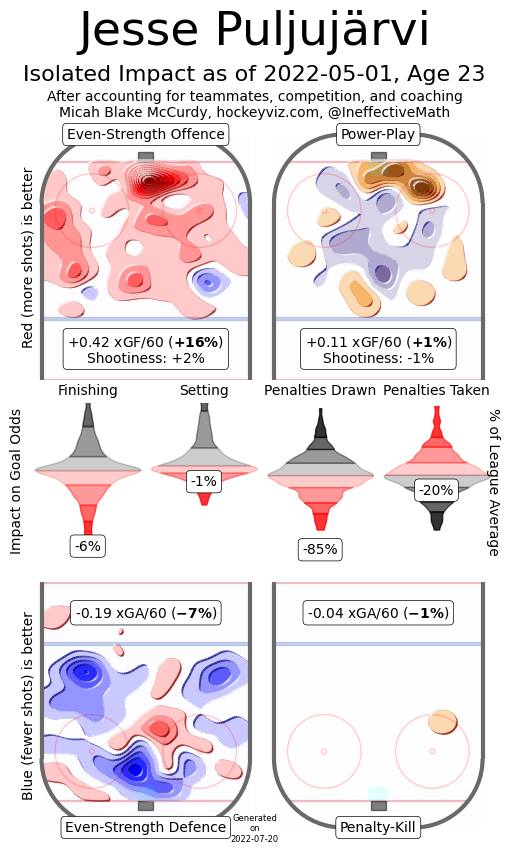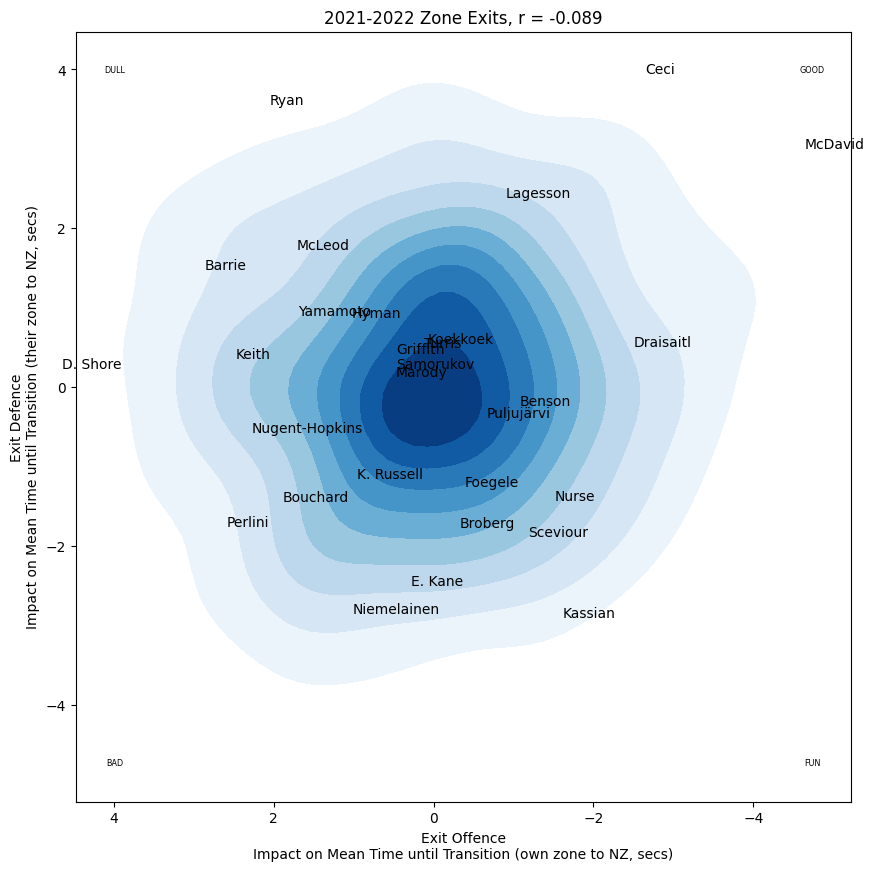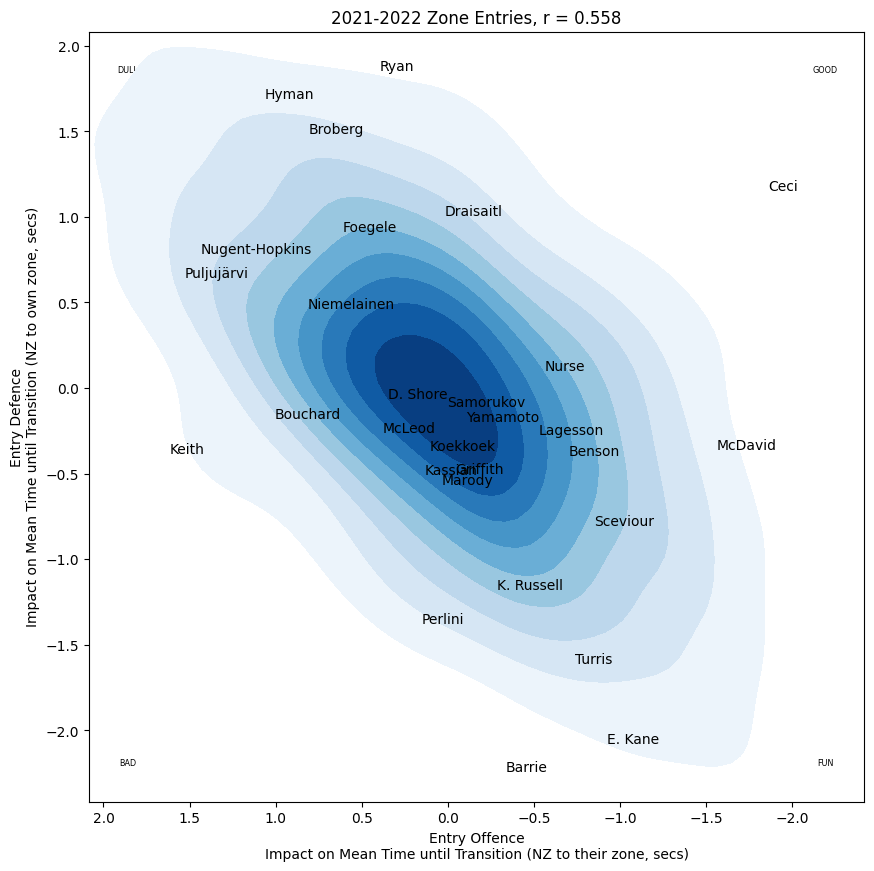Since Jesse's the last big remaining controversy for the Oilers this offseason, I want to take a look at what he brings to the team, what he doesn't bring to the team, why the Oilers should keep him, and how they should use him if they do. The argument tends to be between the fancy stats crowd and the traditionalists (I'm in the former camp), but I want to try and explain how boxscores underrate Jesse and what the more complex models see in him. To do that, I should explain how a spreadsheet sees the game of hockey.
One way to model hockey, used largely by the wonderful Dr. Micah McCurdy of hockeyviz.com, whose work will show up a lot here, is to view it as 2 distinct interactions. The first interaction is generating and suppressing
expected goals. Expected goals, or xG, is a stat that assigns value to each unblocked shot attempt (goals, saves, misses (including pings) at the moment it is taken, based on the probability of the shot becoming a goal. So a shot that has a 20% chance of scoring is worth 0.2 xG, while a 50/50 chance would provide 0.5 xG. The model that does this includes a multitude of factors, most importantly the location of the shot, but also the type of shot, whether it occurred off the rush or was a rebound, how many skater each team has on the ice, etc. The details of Dr. McCurdy's model can be found here: https://hockeyviz.com/txt/xg5 , though generally each stat website uses their own model. Importantly, who the players involved in this shot, either shooting it or attempting to save it, or setting it up, are not part of the xG calculation. So an Alexander Ovechkin slapshot set up by Jonathan Huberdeau against Craig Anderson would have the same xG value if it were taken by me, set up by you, against prime Dominic Hasek, assuming all that changed was the players. Those shots obviously are not equally likely to result in goals, but that difference is part of the second interaction. The generation of xG is an interaction between
all 10 skaters, since everyone has an assignment on defence, more viable transition outlets makes breakouts easier, and everyone participates in cycling in the offensive zone, etc. Important skills in this interaction include forechecking, transitional passing/skating, and everything to do with skater defence.
The second interaction is between the shooter, setter (the player who would receive a primary assist if this shot were to result in a goal), and the goaltender, and can be measured by the difference between the expected goals and the actual goals. The stat GSAx (Goals Saved Above expected) from evolving-hockey.com is a good example of using xG to measure goaltending. Micah uses percent increase in the chance of a shot becoming a goal with a player as either the shooter, setter, or goaltender, with negative numbers signifying a decrease in goal probability vs. a league-average player. This interatcion is notoriously inconsistent and difficult to measure (goalies are voodoo and William Karlsson's 40-goal season has yet to be explained by either science or magic) Importantly, this interaction
only involves the shooter, setter, and goalie. Also of note: since the NHL doesn't track who would have gotten a primary assist on non-goals, they are estimated based on hand-tracked data from the wonderful Corey Sznajder. The data is unfortunately incomplete, but as you read this Corey is probably tracking a game to make it less so. Corey has probably watched more hockey than anybody else on the planet.
Now let's look at Jesse:

Jesse is a below-average setter and a woeful finisher, who shoots slightly more than the average forward (shootiness is a measure of how much a player shoots). His impact on the powerplay is fairly average and he's been seldom used on the penalty kill. He generates scoring chances at an elite rate and suppresses them at a very good one.
Some people ask "if Jesse's such a good player how come his career high in points is 36?". The answer is that Jesse is bad at the aspects of hockey that directly lead to goals
for himself and primary assists, but extremely good at the other interaction,
the one every player has to participate in.
Micah also helpfully provides some helpful stats on the impact of players on the forecheck and in transition, the Oilers' impacts are here:


Jesse's a solid forechecker and puck carrier out of his own end. While he doesn't throw many hits, he can use his size and reach to take away space in the neutral zone, which makes him one of the Oilers better forwards at denying opposing zone entries. He's strong in puck battles and steady as a puckhandler, using his size and strength to maintain control of the puck when pressured. He's not particularly great at entering the opposing zone, and isn't particularly aggressive on the forecheck. He's more like a centre in a lot of those situations, controlling the NZ and preventing rush chances, while allowing his teammates to aggressively chase down the puck. This fits very nicely with McDavid, who can use his utterly absurd speed to hound these puck carriers about as well as any player in the NHL. McDavid's speed in these spots is why the Oilers have typically paired McDavid with RNH or Drai, natural centres who can take the traditional centre role on the forecheck. Jesse with McDavid frees them up to drive their own lines. And speaking of Drai...

Leon's another guy the fancy stat crowd and traditionalists have argued over, with the Athletic's Dom Luszyczyzyn (pronounced loose-ch-shin) famously leaving him off of his Hart ballot the year he won it. His goal and point totals are incredible largely because he's one of the league's absolute best at turning xG into real G. But he's only good at generating those xG and his defence has been an issue for his whole career. Jesse solves both problems, generating chances for Drai to capitalize on and covering his weaknesses on the defensive end.
Jesse's rush defense has also helped a D corps that struggles mightily on that end. The Oilers really only have a couple good rush defenders. Cody Ceci and Brett Kulak help, but the rest of this corps is either very passive or inexperienced and vulnerable. Jesse's steadiness at F was a huge part of Edmonton's 5v5 defence this year finally reaching league average in spite of a D corps largely formed of offensively-minded players, cheap players, and bad decisions.
The Oilers don't need setting and finishing. They have two of the best of the league at those skills, along with other strong finishers like Evander Kane and Kailer Yamamoto, and another great setter in RNH. What they need is the xGs for those guys to turn into goals, and cover for their weaker defensive players. That's Jesse's skillset, making him a perfect fit in Oil country.


